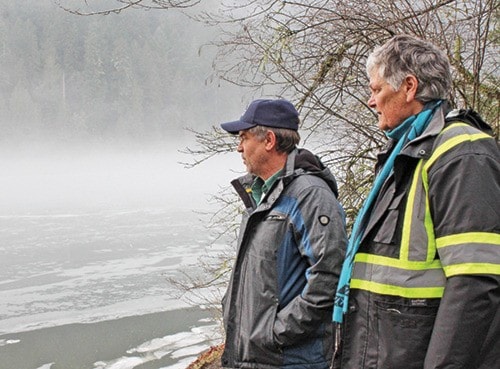In partnership with Tsartlip First Nation and BC Parks, the SeaChange Conservation Society is continuing their work with the Tod Inlet in undertaking two major restoration projects.
The projects include debris removal and beach enhancement.
The debris removal, which will start soon, is based on a mapping survey that occurred in 2015 during the summer. The crew had an underwater camera and GPS unit and were able to identify where the debris was in the Tod Inlet.
“We’re talking about metal scrap material, boat parts, boat batteries, boat motors, much of it left over from the time when the boat works here were being done,” said Nikki Wright, Executive Director of SeaChange Conservation Society.
In the near future, she said, they’ll be going out close to the border of the park, just beyond Butchart Gardens and Butchart Cove, looking at that with a side scan sonar. There, she said, is where they expect to see more derelict boats.
For the smaller debris they are equipped with a WCB certified dive team to remove that with lift bags to move it out of the seabed and into a pile they can classify as recyclable material or material that goes into the landfill.
“That will basically clear off the seabed of smaller debris all the way up to the border of the park,” said Wright.
Anything larger that divers can’t lift, such as boats, they will have a crane and barge come in to remove them.
The remaining structure of the dock is a derelict wharf, once used by a cement manufacturing operation, and contains creosote logs. Creosote, Wright said, is known to continually pollute the waters.
“Under the water there is the debris that was left from the cement manufacturing days which was from 1904 to about 1921,” said Wright.
Limestone was mined out of the area and processed where there is the remnant of one of three chimneys. The limestone was burned with other materials and combined to make cement.
Wright said that’s why the derelict wharf is there, as large boats would come in and offload the cement, taking it to the markets.
“Unfortunately, during that whole manufacturing process, much of the debris that came from the kilns was dumped here on the shore,” she said, pointing to the area of the Inlet.
Much of the brick debris can still be found if individuals walked around the area. The bricks, at the time, had to be replaced on a regular basis in the furnace and were used as fill for the beach front. This caused a lot of chemical pollution, as well as brought the PH of the water up.
The next project is beach enhancement work, which has been going on for a while. It will cost around $125,000 and the group will remove soil and sample it so they can figure out its fate.
“We’re also putting clean sand on the beach and then clean gravel further into the lower intertidal and the shallow, sub-tidal areas,” she said, adding that it will cap the beach area so that marine life can then start to live there.
Wright said it will also be a much friendlier place for park visitors. They’re waiting for final approval for the beach project from the federal Department of Fisheries and Oceans and B.C Parks, but are expecting that shortly.
As for the marine debris removal, they are waiting for warmer temperatures before they begin.
Funders for the projects include the Pacific Salmon Foundation, SeaChange contributions, BC Parks, volunteers from the community and Eco Action.
The project is also supported by other First Nations groups on the Saanich Peninsula.
For more information visit seachangesociety.com.
